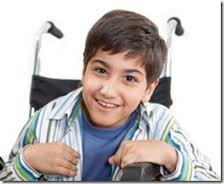Spastic Hemiplegia Cerebral Palsy
Many people may not be aware there are many forms of cerebral palsy, with some forms being a mixture of more than one type. Spastic hemiplegia is one of the more common types of CP. The word “spastic” refers to stiff muscle tone, and “hemiplegia” simply means that the condition affects only one side of the body.
Brain damage in the womb or during the birth process can cause the condition although it may also occur shortly after a baby is born. In the majority of people, one side of the brain affects the opposite side; in other words, if damage occurs to the left side of the brain, it will affect the right side of the body. It can be difficult to understand this condition and how it affects the body, but we will attempt to provide some insight in this article.
Symptoms of Spastic Hemiplegia

Spastic Hemiplegia
There are some distinct symptoms that those with spastic hemiplegia might experience, and while there are many possible difficulties associated with the condition, not every patient will experience every problem. Like other forms of CP, some people have mild difficulties while others experience very severe disabilities.
Sometimes the symptoms can be temporary, but those affected may experience any number of the following difficulties:
- Problems walking.
- Problems with balance.
- Difficulty with tasks that require use of the hands such as writing or sewing.
- Muscle stiffness and weakness on one side (the most common sign of the condition).
Children who suffer from hemiplegia may suffer developmental delays such as sitting, crawling, walking, or talking at a later age than other children. Seizures may also occur in some people with this condition. It can also affect a person’s intelligence with approximately twenty-five percent of children who have spastic hemiplegia suffering from intellectual disabilities.
Causes
There are several causes that may contribute to the development of spastic hemiplegia. Strokes are one of the causes, but many people do not realize children, unborn babies, and newborns can suffer strokes which result in brain damage and the development of cerebral palsy. Some other factors that can lead to spastic hemiplegia include:
- Injuries to the head or oxygen deprivation during birth (most common cause).
- Brain tumors.
- Sturge-Weber Syndrome (a congenital condition).
- Migraine syndrome (this is a collection of different symptoms that include headaches, disturbances in vision, and nausea though this is usually temporary).
- Meningitis, encephalitis, and other infections of the brain. If the mother develops infections during pregnancy it can also lead to brain damage in the unborn child.
- Multiple sclerosis and myelitis (frequently resulting from vasculitis).
- Nonketotic hyperosmolar coma, a complication of diabetes.
- Hereditary diseases called leukodystrophies.
- Arteries and veins that do not form properly can also cause spastic hemiplegia.
Treatment Options

Spastic Hemiplegia Therapy
The standard and most common treatment for spastic hemiplegia is physical therapy, just like with other forms of cerebral palsy. This can involve any number of methods all of which place their focus on building strength in the muscles and preventing further muscle stiffness.
Patients with spastic hemiplegia often seek medication in order to relax their spastic muscles and treat any seizures and other complications that may occur. If there are deformities in the limbs, surgery may be helpful, but prevention is the actually the best treatment for this type of problem. Parents can accomplish this with braces, constraint therapy and other types of orthopedic devices that help support the child’s movement and prevent the limbs from becoming deformed.
If you have a child who is suffering from spastic hemiplegia as the result of a brain injury that occurred due to possible medical malpractice, we invite you to call 1-855-833-3707. We can help you assess your legal options (if any exist), and there’s no cost for this consultation.
